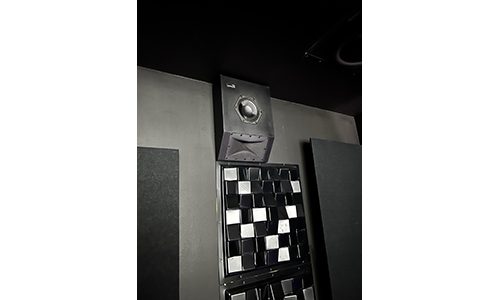The high-end home audio market is filled with products that promise a lot. The problem is that in a majority of those cases, those promises never come through, but in the case of Calif.-based Grimani Systems, the company provides more than just a high-end audio solution.
According to Grimani Systems co-founder, Anthony Grimani, the company’s entry into the home loudspeaker market wasn’t necessarily by choice. The company’s launch is the result of Anthony and his partner Manny LaCarrubba, addressing a need within the consumer electronics space for high-performance components that could meet the expectations of discerning clientele.
Grimani Systems Focuses on the Entire System
Anyone that’s ever spent any amount of time attending the CEDIA Expo and, attended any of the show’s training sessions inevitably knows that designing a good home entertainment system can be extremely difficult. Those differences go far beyond just the choice of one loudspeaker over another or buying expensive cables for example to “solve” system problems.
Grimani underscores that design includes not only the choice of amplifiers, speakers, and source components, but it also includes speaker layout, seating locations, room construction and materials, and addressing the room’s dimensions.
He is also cognizant of the role of integrators and what challenges dealers face when trying to install these components within a range of household environments.
“I really didn’t want to start a speaker company—the short story is—we felt as an engineer and designer of theaters that it was time for a newer generation of speakers that brought that whole feel into the 21st century, and it made life for integrators easier. We kept looking for speakers that could play loud enough for film soundtracks and still be audiophile grade and we couldn’t find them. We kept looking for speakers that had high SPLs [sound pressure levels], while also having uniform audience coverage,” recalls Grimani.
“We could not find them … we were looking for advanced speaker systems that networked and could operate in the IoT [Internet of Things] and we could not find them. We tried. We kept looking for speakers that were skinny that could fit behind screens and could not find them. I never thought I was going to start a speaker company. It wasn’t in the master plan, but the frustration got bigger and bigger.”
According to the popular acoustician, what really separates Grimani Speakers from other high-performance speaker companies is that his company offers a combination of quality products and years of experience of working with dealers in the custom installation industry. Grimani notes that he is no different than integrators in the field because he has been on his hands and knees crawling through attics and basements pulling cable just like them, so he understands the hurdles integrators face in the field.
Further separating Grimani Systems from other speaker companies he continues is the acoustic design services the company provides to ensure the systems perform to their highest possible levels. Grimani emphasizes the room speakers reside in play a major role in how a system will perform so those issues should be addressed as part of a system installation.
“Very simply put: What goes into your ear canal is sound from reflected surfaces from within the room. It makes sense that you want to take control of the character of that reflected sound. To elaborate: A typical modern speaker that has wide dispersion has one vector of sound that goes to the listener and hundreds of vectors that go throughout the room to the listener. If you look at how much sound is come from the direct sound to the reflected sound, it is about two- to three-times more reflected sound that is coming to the listener,” he explains.
“You want that reflected sound. You want to take control. That’s one way to look at acoustics. Having the right absorbers and the right diffusers in the correct places. I like to separate the conversations. There are two parts to cooking up nice sound for a room. You need both: You need control of what the sound reflections are, and you need some control of the frequency control/balance in the listening seats.”
For a minimal investment he goes on to say, homeowners can double their sound quality by simply controlling what is reflected to them in the listening area.
“I use the word of take control rather than eliminate; you still need some reflection to have it sound natural,” he stresses.
Without getting too complex, the co-founder of Grimani Systems also points out that acoustics entails more than just diffusion and absorption. Grimani states that every room within a home that houses an audio system is subject to standing waves so thought needs to be applied to controlling room proportions, including where to put the seating, the speakers and subwoofers.
“There are specialty treatments that are made for absorbing and controlling low frequencies and you need to judiciously use those,” he points out.
“The other part is sound isolation and noise control. That is also in the realm of acoustics. People don’t think of if you want good sound, you need the elimination of noise because that noise masks sound. If you build a room with good sound isolation, you get two benefits: Privacy and you get a much lower noise level in the room because you get all that background noise out of the room. The benefits can be substantial.”
Understanding the Big Picture Provides the Best Value
Reiterating some of his earlier points, Grimani says that a home AV system encompasses so much more than just nice equipment. He advises that dealers and homeowners consider the entire picture, including the room, as well as placing an emphasis on stable, reliable power in addition choosing components such as amplifiers, projectors, speakers and TVs.
Accentuating this wholistic approach, Grimani says that Grimani System’s services span from fundamental design elements to more elaborate solutions that include loudspeaker systems, and the entire gamut of home theater design, which includes video.
“Depending on the scope of work, in most cases, we design the audio and video systems. I am an international ISF (Imaging Science Foundation) instructor. We handle video design. Our work is always involves interior designs, architects and builders,” points out Grimani.
Emphatically he adds that it is important for integrators and homeowners not to pigeonhole the scope of services Grimani Systems offers. He acknowledges that a complete system with loudspeakers and design services can be expensive, but Grimani Systems also offers reasonable solutions that are approachable for a wider demographic of homeowners.
“This is a dual prong question. As far as consultation, we’ll do a consultation for about $500 where we’ll talk about what they [the consumer] are trying to accomplish. Our design services start at $500 for two hours of consultation or up to $80,000 for 400 hours of engineering, documentation, calibration and follow through,” comments Grimani.
“On the speaker side, we don’t have that wide of a range. We carefully hand build our speakers in our shop in California. So, the speakers are high quality, and they are expensive. Our lowest cost speaker is $2,900 including amplification and $15,000 including amplification per speaker. At $4K per speaker that is not rock star price levels, but it is higher quality.”
Admittedly, he notes that modern home AV systems are very complex, and there are simply no miracle solutions that can magically fix subpar components or poorly thought-out designs.
“You can break the study of acoustics into three chunks: When you think like an acoustician, you think about how speakers radiate into a room and how your room is affecting the radiation of the sound. The second part is sound isolation, which should be looked at from the point of view of privacy and controlling the background noise. That is specialty construction. The third discipline is noise control. You want a room that is really quiet, which means you can’t have noisy ventilation, you can’t have noisy projectors, noisy fans, or else you are masking the fine detail of the music or content,” explains Grimani.
“If you take care of these things, instead of spending money on amps, cables, and you have an isolated room that controls reflection, then you’ll have a vast improvement in sound quality. You’ll hear detail, articulation, which is all of that stuff that is messed up by the echoes of bad acoustics.”
More news from Grimani Systems: The Don of N.Y. Electronics: DSG Metro’s Dave Silkin







